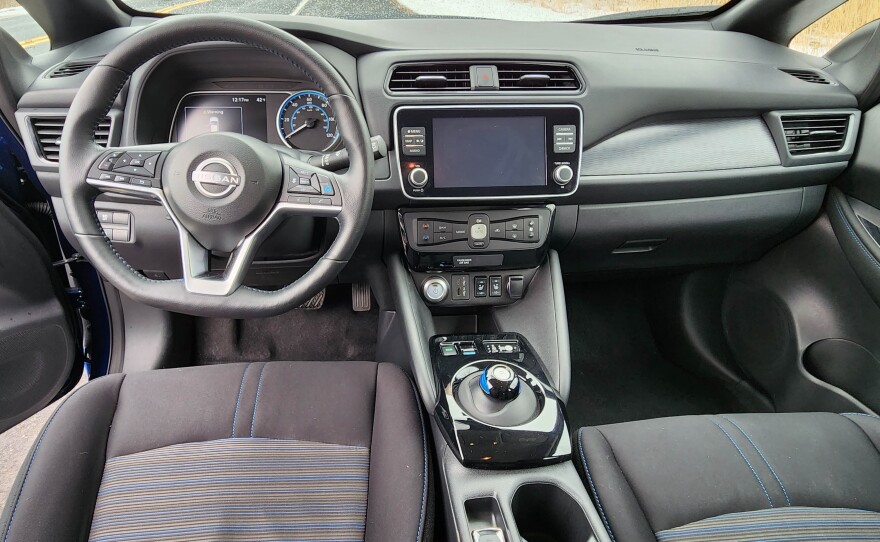All credit to Nissan for being the first major car maker to launch an all-electric model, the Leaf. Seems like yesterday.
But no, Leaf has been around more than a dozen years and remains the most affordable electric, and one that still is eligible for a $7,500 tax credit. Not only that, but Leaf is also a cute hatchback that has abandoned its awkward birthing looks to be a useful city car that most of us could afford.
Equally as important, it can be plugged into a standard 110/120 outlet and charged enough overnight to run a typical day’s errands or the jaunt to work and back. Is it the car you’ll want to drive cross country? Probably not, but the tested Leaf SV Plus would get you to Madison and back on a full charge.
Nissan’s Leaf still is short of range compared to most other EVs. This top-level SV Plus having 212 miles on a full charge, while the base Leaf offers just a 149-mile range. Cold weather will cut into that some too as I had the test car on a morning that started about 10 degrees with a noontime of 24. While the digital dash claimed 212 miles of range on a 100% charge, a roundtrip to church (about 8 miles) sucked 22 miles of range.
On a 40+ degree day the mileage use was about 2.5 miles per percent, so range was near the full 212, depending on if I were to engage the Power mode instead of Eco. That boosts acceleration noticeably, but cuts about 10 miles off the battery range. Turning off the radio and climate controls also saves five to seven miles, but most of us prefer heat and A/C in the proper seasons.

For the record, Nissan says recharging Leaf at a fast charger (only a few even available in Milwaukee at a South Side Walmart) can boost its battery power from near 0 to roughly 80% in 40 minutes. That’s slower than most other electrics that can do a similar charge in about half the time to 30 minutes. If you install a 240-volt charger in your garage a full charge can be had in 11.5 hours for the longer-range SV Plus, or 7.5 hours for the base Leaf.
For practical purposes though, an overnight charge will net you 30-40 miles of range for the next day, and lets face it, most of us would try not to run our batteries to zero.
So let’s turn our attention to driving, a key element for any vehicle, yes?
Well, the Leaf rides on a 106.3-inch wheelbase and with its lithium-ion batteries tucked into the car’s floor, its center of gravity is low, which is something that’s like most electrics. That helps the car corner well and feel well-planted on the road although this is front-drive, and no AWD is available. The steering is quick.
The car’s 214 horsepower and instantaneous 250 pound-feet of torque help it smoothly slip away from any stoplight. In Eco mode, that’s nothing special, but press the Eco button on the console and Power mode engages to help Leaf shoot away from most any other vehicle at a stoplight. It’s fun, like other electrics.
There’s also an e-Pedal function that allows for one-pedal driving. Engage it on the console and there’s more regenerative braking pull to quickly slow the car once you take pressure off the accelerator. Not only does it aid in slowing and stopping, but it also helps slightly recharge the batteries to extend range. If e-Pedal is not engaged, the car coasts like a standard vehicle would once you let off the accelerator.
The ride is the only downside, and it’s not atrocious, just jiggly. Our crumbling streets stir up the interior a bit, but I’ve witnessed tougher rides in $75,000 trucks and SUVs. Note too there’s some road noise and some whine from the electric motor, which becomes most noticeable at slow speeds. The Leaf also chimes when backing up to alert pedestrians that the hatchback is moving since there’s no engine noise to warn them.
Inside the tested dark metallic blue SV Plus featured a mostly black plastic interior, at least for door trim and dash. The seats are a soil-resistant soft cloth, black with blue horizontal stripes. It’s attractive and the headliner was gray.
There’s no sunroof, but the SV Plus does perk up the accessories vs. the base model. This one comes with two-level heated front seats and a heated steering wheel and side mirrors, a heat pump for quicker interior warm-ups, plus a 360-degree camera, 8-way power driver’s seat, cargo cover and the premium paint job. SV Plus also adds smart cruise control and steering assist to the safety suite, which comes with automatic emergency braking with pedestrian detection, lane departure warning, blind-spot warning rear cross-traffic alert and rear automatic braking standard.
I like the flat-bottom steering wheel that helps open up knee room for easy egress and the fine touchscreen that makes radio and info control easy. The driver’s digital gauges can rotate between screens, but a wise driver likely will leave up the one telling how much charge is left.
The seats themselves are well shaped and supportive and there’s room enough for four adults assuming normal stature. The cargo space is good behind the rear seats, but those split and fold down if needed. The hatch is manual.
Sadly, there is no wireless charger here, but plugs are available just above the open bin at the center stack’s base. Yet there is Apple CarPlay and Android Auto connectivity and Nissan Connect allows you to use your smartphone to check the car’s charge level. Satellite radio also is standard.
From a practical standpoint, the two charging outlets are in the nose under a flap remotely released from the left dash. One outlet is for a fast charger, the other for a 240- or 110-volt outlet with an adapter. A satchel in the trunk is provided to stow the charging cable.
Pricing, as alluded to earlier, is attractive for Leaf, especially if you want a second car for city driving, mostly. The base model with the 149-range lists at $29,135 including delivery. It only packs 149 horses, but you’d be buying this version totally for efficiency.
The more well-equipped SV Plus starts at $37,135, with delivery, and the test car added just $160 kick plates so settled at $37,295 which is well below the average cost for a new vehicle. Note too that Leaf is still eligible for a $7,500 tax credit as this is built in the U.S., in Tennessee. There’s also an eight-year, 100,000-mile battery warranty.
If the price alone isn’t enough to get you to turn over this new Leaf, well, there are a few competitors to consider. Each has a longer range. Prime competitors include the Hyundai Kona with a 258-mile range, Chevy Bolt at 259, and Kia’s Niro at 250 miles. Bolt costs about $32k, Kona $35k and Niro $41k. Again, most charge at least somewhat more quickly than the Leaf, but none beat its entry-level pricing, and some may not be eligible for a tax credit.
FAST STATS: 2023 Nissan Leaf SV Plus
Hits: Useful hatchback, good acceleration (and power mode), quick handling, reasonable charge times, flat-bottom wheel, heated seats/steering wheel, power driver’s seat, 360-camera, smart cruise, solid safety equipment, comfy seats, nose-mounted charging, e-Pedal mode, fine touchscreen, and modest cost.
Misses: Ride is a bit jiggly, some road road noise, just 212-mile range, no wireless charger or sunroof.
Made in: Smyrna, Tenn.
Engine: 160kW AC Synchronous Motor, 214 hp/250 lb.-ft. torque
Transmission: 1-speed direct drive automatic
Weight: 3,900 lbs.
Wheelbase: 106.3 in.
Length: 176.4 in.
Cargo: 23.6-30 cu.ft.
MPGe: 121/98
Range: 212 mi./212 observed
Base Price: $37,135 (includes delivery)
Invoice: N.A.
Major Options:
Kick plates, $160
Test vehicle: $37,295
Sources: Nissan, www.kbb.com













